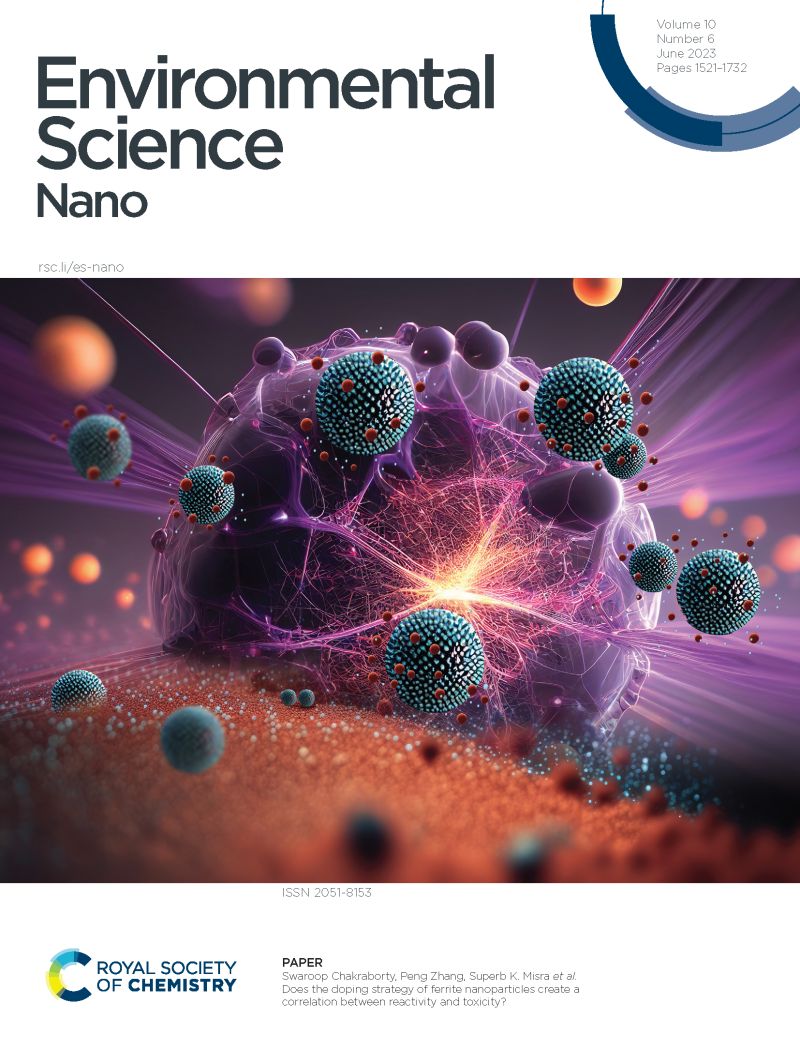Multigenerational Exposure to Nanomaterials Induces Transgenerational Memory without Detectable Genetic Alterations in Arabidopsis thaliana
IF 5.1
2区 环境科学与生态学
Q1 CHEMISTRY, MULTIDISCIPLINARY
引用次数: 0
Abstract
The increasing exposure of engineered nanomaterials (ENMs) in agriculture, whether intentional or unintended, has led to growing concerns about their long-term biological impacts. While short-term nanomaterial exposure effects have been extensively studied, the multigenerational effects and potential transgenerational inheritance remain poorly understood. Here, we systematically investigated the biological effects of long-term nanomaterial exposure across multiple plant generations using Arabidopsis thaliana as a model system. Five chemically distinct nanomaterials (carbon dots, SiO2, TiO2, Fe3O4 and graphene oxide) were applied through root exposure for five consecutive generations (T1-T5), followed by a nanomaterial-free recovery generation (T6). Whole-genome sequencing revealed no detectable genetic alterations in ENM-parental-exposed T6 plants compared to the parental-unexposed T6 control ones. Strikingly, transcriptional profiling found significant changes in gene expression, and the expression differences almost align with the phenotypic traits observed in the nanomaterial-treated T1 generation. Phenotypic traits, such as enhanced biomass accumulation originally induced in T1 -T5 generations persisted in T6 plants despite nanomaterial withdrawal, suggesting the occurrence of transgenerational memory. Our findings provide the first experimental evidence that multigenerational exposure to these five nanomaterials induces no detectable genetic alterations but transgenerational memory in Arabidopsis thaliana, offering new insights for sustainable nano-agriculture development.多代暴露于纳米材料诱导跨代记忆在拟南芥中没有可检测的遗传改变
工程纳米材料(enm)在农业中的暴露越来越多,无论是有意的还是无意的,已经引起了人们对其长期生物影响的日益关注。虽然纳米材料的短期暴露效应已被广泛研究,但对其多代效应和潜在的跨代遗传仍知之甚少。在这里,我们以拟南芥为模型系统,系统地研究了长期暴露于纳米材料的多代植物的生物学效应。5种化学性质不同的纳米材料(碳点、SiO2、TiO2、Fe3O4和氧化石墨烯)通过根部暴露连续施用5代(T1-T5),然后进行无纳米材料回收代(T6)。全基因组测序显示,与未暴露的T6对照相比,暴露于enm亲本的T6植株没有可检测到的遗传变化。引人注目的是,转录谱分析发现基因表达发生了显著变化,并且表达差异几乎与纳米材料处理T1代中观察到的表型性状一致。表型性状,如最初在T1 -T5代诱导的生物量积累增强,尽管纳米材料退出,但在T6植株中仍然存在,表明存在跨代记忆。我们的研究结果首次提供了实验证据,证明多代接触这五种纳米材料不会引起拟南芥可检测的遗传改变,但会引起跨代记忆,为可持续纳米农业的发展提供了新的见解。
本文章由计算机程序翻译,如有差异,请以英文原文为准。
求助全文
约1分钟内获得全文
求助全文
来源期刊

Environmental Science: Nano
CHEMISTRY, MULTIDISCIPLINARY-ENVIRONMENTAL SCIENCES
CiteScore
12.20
自引率
5.50%
发文量
290
审稿时长
2.1 months
期刊介绍:
Environmental Science: Nano serves as a comprehensive and high-impact peer-reviewed source of information on the design and demonstration of engineered nanomaterials for environment-based applications. It also covers the interactions between engineered, natural, and incidental nanomaterials with biological and environmental systems. This scope includes, but is not limited to, the following topic areas:
Novel nanomaterial-based applications for water, air, soil, food, and energy sustainability
Nanomaterial interactions with biological systems and nanotoxicology
Environmental fate, reactivity, and transformations of nanoscale materials
Nanoscale processes in the environment
Sustainable nanotechnology including rational nanomaterial design, life cycle assessment, risk/benefit analysis
 求助内容:
求助内容: 应助结果提醒方式:
应助结果提醒方式:


